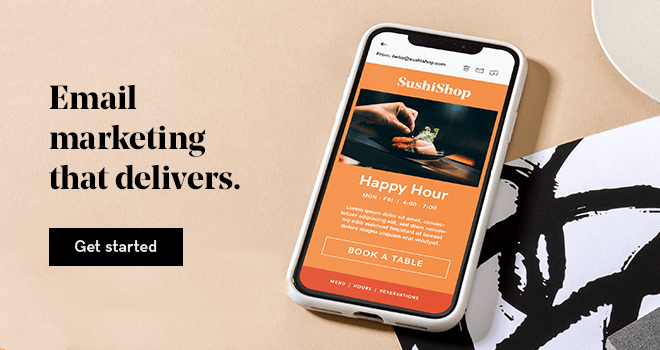As a web pro or marketer, you're being pulled in a thousand different directions every day. Between running your business, networking, managing projects and the million other things on your to-do list, marketing can fall down the list of priorities. But it doesn't have to be this way! Marketing automation is here to help you do everything from keeping your social accounts updated to converting leads into sales for yourself or your clients.
Four in five users increased their leads by using marketing automation software.
And, it works: four in five users increased their leads by using marketing automation software, and almost as many (77%) saw an increase in conversions.
Guide to getting started with marketing automation
In this post, we'll explain what marketing automation is and how it can help you run your business more efficiently. Then we’ll guide you through the steps of setting up your own marketing automation system.
Here are the topics we'll cover:
- What is marketing automation and why should you care?
- What's the value of a marketing automation system?
- Planning for automation.
- Your CRM and list.
- Setting up a marketing automation system.
- Plan your workflows.
- Popular marketing automation systems.
- Recap and next steps.
Let's take an in-depth look at how to get started with marketing automation.
What is marketing automation and why should you care?
Have you ever hopped online to discover your competition seems to be publishing content like clockwork, keeping their social media channels full of rich content and refreshing their landing pages with their newest product?
You can bet they're using marketing automation to keep in touch with their prospects and relieve some of the workload.
Techopedia defines marketing automation as “the use of software and web-based services to execute, manage and automate marketing tasks and processes. It replaces manual and repetitive marketing processes with purpose-built software and applications geared toward performance.”
Marketing automation software helps you save time so you can focus on building the relationships that bring you business.
If you're looking for a marketing automation system for your own business or are taking on the task of finding a solution for a client, here some things today's leading marketing automation programs can help you do:
- Gather marketing intelligence
- Manage your workflow
- Create web-based archives and real-time traffic analysis
- Manage, nurture and score leads
- Create and monitor marketing campaigns
- Integrate or use a built-in CRM
- Develop/manage landing pages
- Orchestrate data
Each of these functions translates into demonstrable value that makes it worth your time and revenue to invest in implementing a marketing automation system.
What's the value of a marketing automation system?
Marketing is about building relationships with potential buyers, warm leads and current customers. Each of these groups requires different messaging on different timelines.
Marketers need to segment and target their marketing accordingly, or risk turning off their audiences with irrelevant, badly timed content.
Marketing automation, according to Hubspot, “allows you to nurture your leads through the entire buying process, delivering highly targeted, personalized messages that address their specific barriers to purchase.”
A web design agency might design an automated email workflow that guides a lead through these steps (we based ours on HubSpot’s example):
Step 1: Send an email to a targeted list of contacts, inviting them to download your eBook on search engine optimization (SEO).
Step 2: They immediately receive their eBook, with a note thanking them for downloading your offer.
Step 3: A couple of days later, the people who downloaded your eBook receive an email asking them if they'd like to see a case study of how you were able to significantly increase a client's ranking — and revenue.
Step 4: You make your case study a downloadable, both so the reader can view it offline and so your salespeople receive a notification about who to follow up with. You've now begun to establish your authority on this topic and added a warm lead to your list.
The statistics on marketing automation don't lie:
- Almost 70% of respondents polled in the 2017 survey said “improved targeting of messages” is the most important benefit of marketing automation.
- Nearly 46% of respondents credited automation with “improved customer experience.”
- More than 37% said marketing automation resulted in “better quality of leads.”
Related: What is hypertargeting and how can you use it to grow your business?
Signs you need marketing automation
When you’ve grown an established customer base and have leads arriving via social media, your website, sales staff and other channels, it can be hard to keep track of everything, effectively monitor your activities and find out which are bringing in the highest ROI (return on investment) for your business.
It might be time to consider marketing automation software if you’re seeing the following signs:
- Leads are being handled inconsistently.
- Your sales process is poorly defined.
- It takes you/your team too much time to acquire, nurture and close leads.
- Prospect and customer inquiries are handled manually.
- You need to retain more customers.
- You’re missing out on opportunities to cross-sell and up-sell clients.
That’s no way to run a business.
But by automating your marketing, you can create and deliver the right message to the right audience when they need it — and in less time, with less stress, than you’re spending now.
When you’re better able to personalize your marketing, respond to leads faster and achieve a higher conversion rate, your profits will rise.
Related: Upselling and cross-selling techniques for online stores
Planning for automation
There are a few steps involved and factors to consider before you start to automate your marketing. After all, marketing automation is supposed to save you time and frustration, but using the wrong platform or trying to automate the wrong activities will leave you over budget and scratching your head.
To prevent that, make these considerations before you invest and onboard in any system:
Which marketing activities can you automate?
Traditionally, marketing automation has been associated with email marketing and social media marketing.
But with marketing technology moving at a pace faster than anyone could have predicted a decade ago, the scope of activities these platforms handle is astounding.
While more content is being created and published than ever before for exceedingly jaded audiences, the need to ensure our marketing is data-driven, targeted and efficient has never been greater.
Luckily, we have a diverse set of tools in our arsenal to help us automate a wide range of marketing activities, including:
- Lead tracking and nurturing
- Social media marketing
- Content marketing (to research, plan and coordinate content generation and publishing)
- User onboarding and engagement
- Cross-selling and upselling
- Website and app operation and optimization
The activities you’ll automate will depend on your (or your client’s) business and services, your team’s goals and other factors unique to you.
Setting goals and priorities for a marketing automation system
The results you achieve with any marketing automation system (or the campaigns you'll build with it) will only be as good as the goals you define going in.
Before signing up for any system, set SMART marketing goals (Specific, Measurable, Aspirational, Realistic and Time-bound) that are in line with your overall business objectives.
Your business's goals might be to:
- Drive more sales
- Increase revenue
- Explore new markets
- Strengthen relationships with stakeholders
- Convince current account holders to renew their subscription (retain customers)
As for how to map those goals to marketing priorities, the top five most important strategic goals of a marketing automation strategy for those polled by Invesp are as follows:
- Increasing lead generation (61%)
- Lead nurturing (57%)
- Sales revenue (47%)
- Improving customer engagement (61%)
- Marketing productivity (57%)
These are general goals — ideas you might want to consider for your own efforts.
Of course, as Salesforce Pardot mentions, it's critical to talk to your own sales teams to identify their needs, requirements and metrics, and discover where the gaps are in your current marketing.
Remember that the quality and quantity of your leads is important.
You need an audience that’s paying attention to what you’re sending out, then engaging with your content. You need to know who your best customers are.
Don't forget to research how your competitors and others in your industry are using marketing automation to achieve their own goals. You'll also want to set long-term goals; you need a flexible marketing automation platform that you can adapt to your business as it grows or changes.
Related: 25 ways freelancers can generate an abundance of qualified leads
Finding the right marketing automation system
There’s a lot of information out there about marketing automation. Ensure you’re working with the most current facts about leading platforms since features and pricing can sometimes change.
You might want to start by doing a search for “small business marketing automation,” restricting your results to the last year to reveal current reviews, roundups, etc.
Here are some criteria to consider when shopping for a platform, courtesy of TechFunnel and Marketing Automation Insider:
Your budget
The cost of marketing software can vary greatly in price, from basic plans provided by small vendors to a full suite of solutions from software giants. Consider upfront implementation, training and ongoing costs, as well as fees for any features you may need later.

Your goals
There’s a lot of diversity among marketing automation software — one program might be best for email marketing, but another may handle social media marketing exceptionally well.
While some marketing automation platforms are targeted to freelancers and micro-businesses, others are more enterprise-friendly.
Maybe you only want to automate certain processes, so an all-in-one suite wouldn’t make sense for you.
Whether you want to grow your lead database, nurture leads or build relationships with contacts, it’s important to know your business and marketing goals so you can find the right system for you.
Your software
Which software solutions do you already have? Chances are, you’ll want at least some of them to play nice with your CRM (Customer Relationship Management) or CMS (Content Management System).
Bonus: Taking inventory of your current programs will help you avoid paying for redundant solutions (e.g. if your new marketing automation tool provides built-in analytics and reporting, you can get rid of any that offer this function exclusively).
Marketing Automation Insider lists other factors that might impact your decision, including:
- Email deliverability
- Data security
- Uptime and performance service level agreements
- Customer service quality
- Whether your content is permitted (only relevant to businesses in highly regulated industries like gambling, pharmaceutical, finance, etc.)
- Scalability
- API access and quality
- Rate of innovation/new feature launches
Related: 10 email automation tools for online business success
Your CRM and list
The importance of your CRM list can’t be overstated. Without one, you don’t have any leads or customers to engage.
You’ll want to establish your contact database before you make the move to automate your marketing, and add to your list on a regular basis.
Leading marketing automation systems either have their own CRMs or provide integrations with dedicated CRM tools like Salesforce.
Established freelancers, marketers and web pros use a CRM to put an expected, predictable return on your sales activities, or growth with current customers. This way, you keep track of your prospects, followers and potential customers via software instead of on social media, through email, or worse, in your head.
Without a CRM, you don't have a way to reach customers in your own space (corporate entities own social media platforms and can change their terms and conditions any time they want), so the integrity of your system and data is critical. As this article on FinancesOnline (a Saas/B2B software reviews platform) explains, modern CRMs help you understand your customer, get important insights from customer data, discover new sales opportunities, generate reports quickly, and more.
Your database might hold in-depth information about your valuable contacts, including:
- A contact’s name, title, email address, social media handles
- The date when you last talked and the topic(s) you discussed
- Sources of leads and their lead scores
- Customer orders and spending amounts
- Recent website visits or other engagements with your brand
- Personal details (customers’ kids’ names, the breed of their dog, a favorite hobby, or other data you can include in an email to keep the relationship friendly)
Related: 5 best practices for customer data management
Setting up a marketing automation system
After you’ve spent some time learning about marketing automation and the various platforms available, you’ll discover that setup can seem daunting at first, but there are many similarities regardless of the option you choose. Though they may have unique configuration paths, there are some core components you’ll want to pay attention to:
Lead scoring and segmenting

Not all leads are equal in terms of quality, because not everyone in your database is ready to buy today. While some are customers, others are warm leads, lost opportunities or considering their options.
When we score leads, we apply “a numerical value to a prospective consumer based on who they are and how they interact with your brand.”
Scoring (or rating) your leads helps you determine who needs more nurturing and who can be referred to your sales staff.
Leads can be scored by two parameters: demographics and interactions.
You can make a reasonable guess at how ready someone is to convert by finding out which pages they’ve viewed on your website, and how often.
For example, someone who’s looked at a pricing page or case study would be closer to buying than someone who read a blog post. You’re more likely to be a serious contender for visitors who have returned to your site multiple times over a few weeks than for those who have only visited sporadically over the last six months.
You can also segment your contact list based on people’s characteristics such as job title or location, so you can create and send relevant messages to specific types of people.
For example, maybe you only want to target founders or executives of startups within a certain state or city.
Using both basic and advanced lead scoring techniques will help you identify and spend your time on your most qualified leads. No more wasting time on unqualified or unsuitable prospects!
Related: Using customer segments to build lasting relationships
Tracking codes
Tracking codes let you find out how well your email campaigns and website are working together. By using tracking codes with Google Analytics, you can see not only how many contacts clicked a link to visit your website, but also find out:
- How long they stayed
- What they clicked on
- Which pages they visited and read
- Where they went from there
To get started, set up your Google Analytics ID, tracking codes and property number and paste them in the appropriate areas of your site.
Fun with forms
Now that you’ve found your marketing automation system, learned about lead scoring and set up your tracking codes, it’s time to create a form. In this example, we’ll use a newsletter subscription form that will later be included in our workflow.
- Create a new form category called Newsletter.
- Enter the appropriate information in the text fields, such as First Name.
- Create another text field for Last Name.
- Follow this process to create new text fields for Email, Job title, Social Handles, etc.
You may want to set the form as not required, given some people might not be comfortable sharing personal information.
The same will be to be true for company name and Twitter handle, but we’ll still want to match up those items in our system, so we’ll include them here as well.
To help encourage full submissions, you can choose to include a quick description noting, “To qualify for premium content, please complete all fields.”
Save the newly created form in HTML so you can eventually wire it into your website’s forms.
With any marketing automation field, forms are built in. Some important forms include email templates, welcome notes and confirmation forms.
Gravity Forms is a helpful form-assist tool for WordPress that collects data up front and passes it to the marketing automation software. This can be helpful if the service were to go down for any reason while someone was trying to subscribe.
Related: Qualifying leads with WordPress forms
Triggers and actions
Triggers and actions are two cornerstones of a comprehensive marketing automation workflow. You’ll hear these terms a lot when it comes time to set up your system.
Triggers
A trigger is an action a customer takes (like filling out a form, subscribing or unsubscribing to a list, clicking a link, visiting a page, etc.) that launches subsequent actions in your marketing or sales workflow. They enter your automation and proceed through your process.
Imagine if you didn’t have to remember to send an email to that website visitor who needed a quote, or shift a customer who’s downloaded your case study into your list of warm leads.
This article by digital marketing agency Adviso identifies three types of triggers, including time-based, action-based and behavior-based:
Time-based triggers
Also sometimes called Events, these are date or time-specific, important instances that are unique to each customer and can be used to connect with your customer.
For example, maybe one of your regular customers celebrates a birthday, anniversary or special day (your customer would have provided you with this information). This is a time-based trigger and you might use it to send them an email or text message with a discount on their next purchase.
Action-based triggers
These are based directly on an action taken by a visitor or user, like submitting a form, visiting a specific web page, clicking on a link in an email, or adding an item to their cart on your eCommerce site.
Depending on the buyer journey you lay out for this visitor, you can create automations designed to convert them into a customer, nurture the lead, engage them, retain them as a customer, or have your sales team follow up.
Behavior-based triggers
These are more complex than action-based triggers in that they’re based on a series of actions (or non-actions).
For example, if a customer changes a value in a personalized field, enters their birthday in another tool that’s integrated with your platform, or a tag is added to their contact profile, they’ve set off a behavior-based trigger.
There’s a science to identifying the right triggers to send your visitor along the buyer’s journey so they convert successfully. Get them right and you can develop a solid relationship with your contact, and ensure your marketing is personalized to their interests.
Actions
Actions are the tasks you do daily to execute your marketing strategy.
Set up your platform correctly and you can automate these tasks.
This helps you save time that you can dedicate to activities that create more value for you and your customers.
Actions might include sending an email, lead scoring on targeted contacts, tagging contacts, moving them from one list to another, copying them to a different list, assigning or removing custom fields on contact profiles, or defining a specified amount of time to wait (e.g. two days) before taking an action like sending an email.
Plan your workflows

Workflows are the foundation of marketing automation because they let you convert those contacts — the people sitting in your database — into customers.
Before your leads make that all-important decision to buy from you, they need to be engaged and nurtured through the stages of your marketing and sales funnel.
To do that, you need to map out your communication with the user and send them the information they need, when they need it, in the context that makes the most sense.
Related: How to nurture your leads with email marketing
Your workflows will unfold based on the triggers you set up earlier.
You can have workflows to welcome subscribers, re-engage inactive contacts, retain customers, and even nurture buyers who hold specific roles (e.g. decision maker, influencer) so you can differentiate your messaging based on audience.
One of the pervasive myths about marketing automation is that it’s impersonal. On the contrary, you can use the insights you glean from a customer’s behavior and submitted profile data to create a sequence of emails tailored to their needs.
Uberflip and Drip have some great examples of workflows to get you started.
Steps to build a solid automation workflow
Here are some steps you might take to build a solid workflow, courtesy of Campaign Creators, Synectics Media and Moz:
1. Define your goals
What actions do you want your audience to take? Do you want them to read a blog post? Purchase an item? Sign up for a free trial? A successful workflow guides them to this destination.
2. Find your triggers
Think about the details of your interactions. How do visitors become part of your workflow — by visiting a page? Subscribing to a list? Filling in a form? Downloading a resource?
3. Build a flowchart to map out your marketing campaign
This is one of the most important steps, since it’s where you’ll plan the buyer’s journey your customer takes, from their first interaction with your site to reaching your goal and converting them.
Step up to your whiteboard (or use your favorite mind mapping software). Starting with your first trigger, plan your email branches (it’s common to change your mind a lot throughout the planning process, so buckle in).
Synectics Media suggests a default naming convention of Email #1 - Working Topic Name. You can then branch from there, sending the person Email #2 - Working Topic Name if they take your desired action. If they do not take action, send them Email #1a - Different Topic Name.
Include direction and key marketing objectives, and make it easy enough for your team to understand. Include details like how much time should pass between your first and second emails.
Related: 6 tips for moving your customer through the sales funnel
4. Segment and score your leads
Use lead scoring techniques and segment your lists according to your goals and priorities. Who do you want to reach first? What message will motivate them?
5. Create your campaign assets and content
These include forms, lists, landing pages, etc. Ensure they’re connected to one another and track them so you can measure their success. You might want to hire an experienced copywriter for this step.
6. Implement your workflow
How you set up your workflow will depend on which marketing automation software you choose. However, most modern platforms have comprehensive documentation, tutorials, how-to videos, blog posts, etc. and offer support if you get stuck.
A word of caution: Be patient and prepare to make some minor tweaks. Your workflow, campaign assets and content may not end up in your software exactly as planned, or you may discover you need to add or delete a few triggers or pieces of content.
Test and fine-tune your workflow and system
You’ve worked hard to choose a platform and build your workflow. Now it’s time to rigorously test it to ensure your links, tags and content are in working order and troubleshoot any hiccups. The testing phase includes a few steps:
Pro tip: Best practice is to set plenty of time aside to figure out exactly what’s going on with your marketing automation workflow and system.
1. Set up a test email address
Mission critical: Create a new email address for testing purposes, since using yours or a team member’s could jeopardize this phase if the address has been used in other parts of the process, advises Synectics Media.
Easy solution: Create a Gmail account (i.e. email+testing@gmail.com) and enroll this into your workflow, setting all the delays to a few minutes instead of days or weeks.
2. Send a test version of your campaign
You don’t have to guess how your campaign will look in a recipient’s email client. You can test it and review your content, links and buttons from your subscribers’ perspective. You can also send your test to your team members to find out how your email looks on different devices, in different email clients.
Each marketing automation system is different, but there should be an option to enter your test email address under Settings within your platform. Add it and click Send Test.
3. View your campaign in both desktop and mobile versions
It’s important that your campaign looks perfect on both desktop and mobile.
Fortunately, your system should easily let you preview your email in both desktop and mobile, using both HTML and plain text. Some systems such as ActiveCampaign offer Inbox Preview, which shows you how your email will appear across popular email clients such as Gmail, Apple Mail, Outlook and more.
4. Send your campaign to a test list
Create a copy of your campaign and send it to a test list. Try team members willing to review it with a critical eye to catch any errors or omissions you may have missed.
It’s useful to test with popular email clients such as the ones above here.
Sending your campaign to a test is the litmus test before you hit the Launch button.
It allows you to test everything, including tags, content and links, and capture contact actions within the reporting function in your marketing automation system.
If your workflow doesn’t unfold as expected during the testing phase, fix any problems and try again.
5. Launch your workflow
This is where all your hard work comes to fruition. It’s time to launch and start welcoming visitors, subscribers and customers!
6. ABI — Always Be Improving!
Don’t just set it and forget it. Analyze how users are engaging with your workflow, then edit and refine as needed. What’s working well? Are you achieving the goals you identified in Step No. 1? Where are people getting lost? User data can reveal invaluable insights to act on.
Popular marketing automation systems
If you’re a marketer just getting started with marketing automation for you or your clients, you’ll likely need a user-friendly, budget-friendly solution you can implement with minimal hassle. We believe these fit the bill. Bonus: All of these integrate with WordPress.
Editor’s note: Any costs mentioned below were accurate at the time of writing; visit each site for the most up-to-date pricing information.
ActiveCampaign
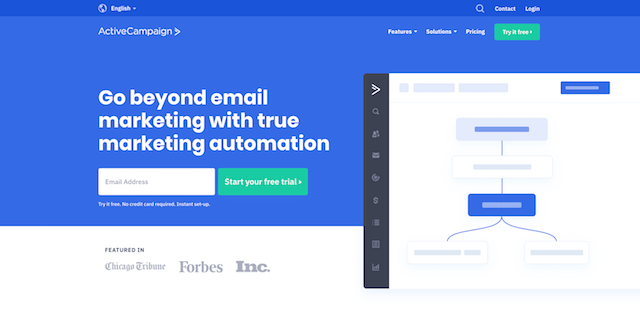
For B2B marketing automation, we highly recommend ActiveCampaign, as it integrates exceptionally well with WordPress. Bringing email marketing, marketing automation, a sales CRM and messaging into one cohesive and easily usable platform, this robust tool offers solutions for everyone from bloggers to enterprise-level customers. Plans range from $9 to $229 per month, starting at 500 contacts.
Infusionsoft by Keap
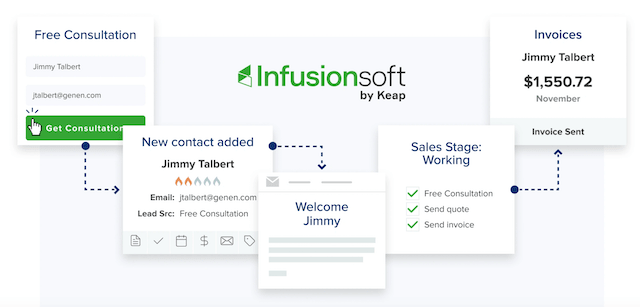
Whether you want to create a landing page in a few clicks, organize leads, get insights on your marketing, create invoices or automate emails, Infusionsoft has it all. Plans range from $200 a month for 2,500 contacts to $400 a month for 10,000 contacts.
Pardo
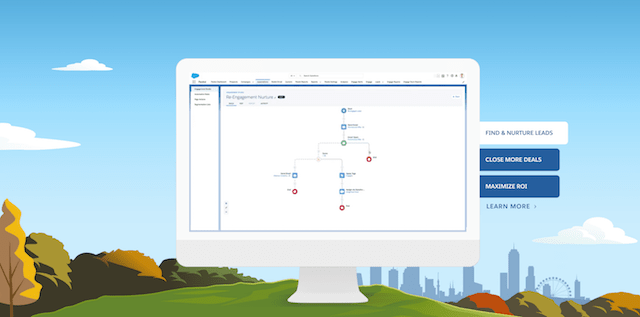
Pardot is often considered a gold standard in B2B marketing automation for manufacturing, education, healthcare, IT and other industries. With a rich feature set and user-friendly interface, the platform offers email marketing, lead management, sales alignment, lead generation and ROI reporting features to build well-crafted marketing campaigns and workflows.
Pardot is geared to Salesforce users (as it integrates seamlessly). The price will be a drawback for many small businesses, with plans ranging from $1,250 to $4,000 per month for 10,000 contacts.
Agile CRM
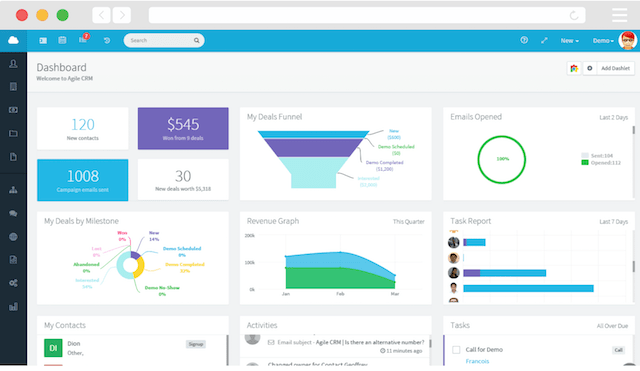
Ideal for small- to medium-sized businesses, Agile CRM is an all-in-one solution that lets you automate your marketing, sales and services on one platform. Loved by users for its clean UI and affordability, it’s a young system — not as established as some others but still has a lot to offer. Plans range from free (for 1,000 contacts and companies) to enterprise level as low as $47.99 per user per month.
GoDaddy Email Marketing
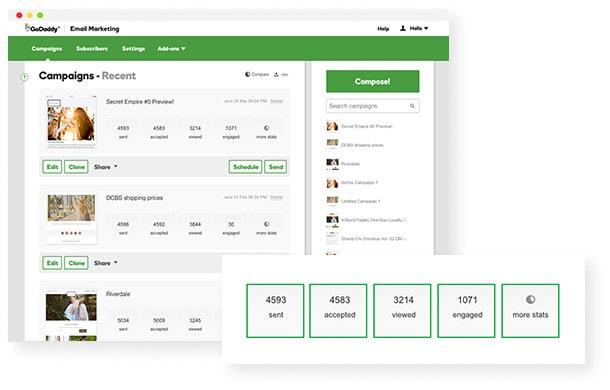
GoDaddy’s email marketing software is a great option for beginners just getting started in marketing automation and who want to focus on email. Its integrations with your GoDaddy website are a huge bonus. Features and functionality are easy to set up, and support is there every step of the way to help with any issues. Plans range from $9.99 per month for up to 500 subscribers to $29.99 per month for up to 5,000.
Recap and next steps
There’s much to learn when it comes to successfully planning, setting up and launching your new marketing automation system. By identifying your requirements, your customers’ needs, doing your research and taking time to properly implement, you can add an essential tool to your marketing arsenal.
Let’s recap what we covered in this guide:
- What marketing automation is and why you should care. Marketing automation platforms can streamline a variety of tasks and processes, including nurturing sales leads and managing workflow.
- The value of a marketing automation system. Bottom line: Marketing automation software helps you save time so you can focus on building the relationships that bring you business.
- Planning for automation. Establish your business goals and find the right marketing automation solution to meet them.
- Your CRM and list. Establish your contact database before you make the move to automate your marketing.
- Setting up a marketing automation system. Pay close attention to lead scoring and segmenting, tracking codes, forms, and triggers and actions.
- Planning your workflows. Map out your communication with the end user using the steps outlined in this guide.
- Popular marketing automation systems. Do your research to find a solution that suits your goals and budget.
Don’t forget that automation doesn’t have to stop at marketing and lead acquisition — you can also leverage automation to create a remarkable experience for your new clients.
Happy automating!
This article includes content originally published on the GoDaddy blog by Christopher S. Penn.
Disclaimer: When using AI tools, avoid entering sensitive information and always review output for accuracy. Additionally, this content is for demonstration purposes only; it does not represent any affiliation, endorsement, or sponsorship with ChatGPT or Open AI. All trademark rights belong to their respective owners. Third-party trademarks are used here for demonstrative and educational purposes only; use does not represent affiliation.


